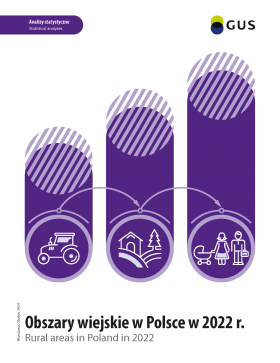Rural areas in Poland in 2022
| Date of publication: | 29.03.2024 |
|
The information contained in the publication provides a statistical basis for programming rural areas development in a changing conditions and allows monitoring the changes occurring in these areas. The publication presents the current state and the changes taking place in rural areas at national and regional levels in comparing years 2015 and 2022. The analysis shows a large territorial diversity of rural areas both in socio-economic and environmental terms. Dynamics of changes is also presented in relation to data of Poland and urban areas. The statistical information has been enriched with maps and charts. The publication presents the analysis in the scope of demographic potential, the economic situation of population, social and technical infrastructure, non-agricultural activity and agriculture, the environment and the sources of rural areas financing. The usage of National Official Register of the Territorial Division of the Country (TERYT), Classification of Territorial Units for Statistics (NUTS) as well as Eurostat and OECD territorial typologies that define urban and rural regions, enables the presentation of phenomena in sections with varying degrees of detail. In addition, in this edition of the publication selected data have been presented in accordance with the Delimitation of Rural Areas developed by Statistics Poland. The purpose of the Delimitation of Rural Areas is to ensure a consistent presentation of the results of statistical surveys on rural areas. Within the Delimitation there were distinguished the following groups of rural areas: high density agglomeration areas, low density agglomeration areas, high density non-agglomeration areas and low density non-agglomeration areas. For comparative purposes, in addition to the analysis of development issues in the above-mentioned territorial breakdowns, the publication also presents for the first time an analysis for the areas of national strategic intervention (ASI) defined in the NSRD 2030 as areas (gminas) threatened by permanent marginalisation. In this edition of the publication the following have been also presented data of the National Population and Housing Census 2021 regarding population, households and persons with disabilities. |
|



